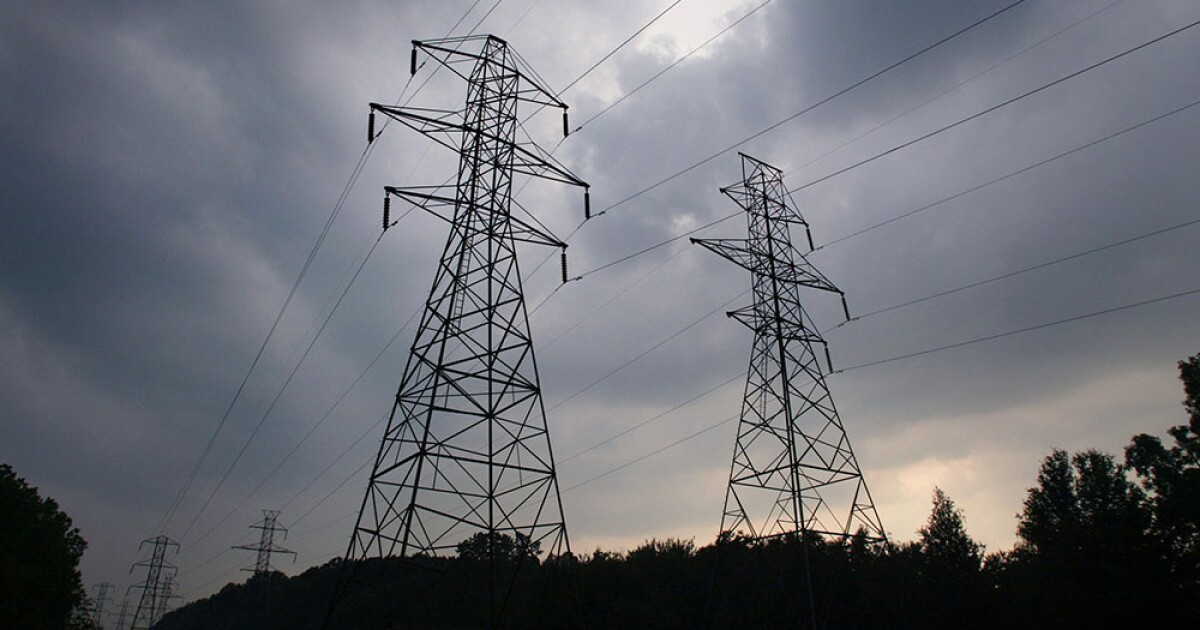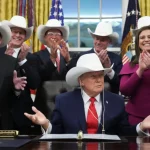

The little-known agency in charge of regulating U.S. energy transmission systems is slated to operate with a bare quorum of just three commissioners heading into the new year.
The dynamics of a three-person board could determine whether the agency, the Federal Energy Regulatory Commission, is able to advance high-profile transmission rules in 2024 — and whether the Biden administration is able to meet its clean energy goals.
FIFTY? BARELY 10 DEMOCRATS COULD CONCEIVABLY BEAT TRUMP IN 2024
Republican FERC Commissioner James Danly stepped down at the end of the year. Democrat Willie Phillips will continue as acting chairman of the commission, with fellow Democratic Commissioner Allison Clements standing to his left and GOP Commissioner Mark Christie to his right. But with Phillips often acting as a “swing vote,” items can be finalized through a 2-1 majority, eliminating the risk of 2-2 gridlock.
This can be particularly significant as the body seeks to address some of the most pressing problems concerning the grid. The rules in question include one requiring utilities to plan for their long-term transmission needs and establish how to pay for projects, in an effort to help alleviate delays. Another rule would reform the process for transmission developers to apply for permits to site interstate facilities if they’re not approved by states.
As permitting reform legislation stalls in Congress, Democrats and clean energy advocates will be looking to the agency to finalize the rules in hopes of speedily connecting renewables to the grid. And with Danly leaving, that could open the doorway for quicker resolution for FERC on the topic of transmission.
Danly was the sole dissenting voice on the planning and cost allocation rule when it was first introduced in April 2022, calling it a “boondoggle” that offers “overly prescriptive regulatory meddling.” In his statement of dissent, Danly argued there is a lack of evidence to show that existing transmission rates are unjust and current planning processes are “so unacceptable that the existing system essentially must be scrapped.” Danly also found issue with the rule’s cost allocation rules, arguing that they would force ratepayers to pay for other states’ policy plans while favoring states that require renewable energy standards.
“I oppose forcing the ratepayers in states with different public policy goals to pay for another state’s plans,” Danly wrote.
Although four commissioners had voted for the proposal last year, when Chairman Richard Glick was still on the panel, much has changed since the rule was initially introduced. The Supreme Court struck down an EPA climate rule regulating greenhouse gas emissions from existing power plants, justifying the ruling on its interpretation of the “major questions” doctrine, which is the idea that agencies do not have the power to issue decisions of national significance without authorization from Congress.
Furthermore, Danly’s dissent on the rule could add fire to a larger legal effort to oppose the proposed rule, shepherded by Republican state attorneys. In a comment to FERC after the unveiling of the rule, 17 GOP state attorneys rebuked the proposal, arguing that it violated the major questions doctrine and drawing heavily on Danly’s arguments.
Transmission wasn’t the only priority that reached an impasse. The commission was temporarily deadlocked on approving gas projects. In July, the commission unexpectedly pulled six proposed gas projects from consideration. While the commission isn’t allowed to discuss internal conversations, statements from the partially dissenting parties had FERC observers predicting that the split was over emissions.
More specifically, some suspected that the panel was divided on how to approach interim guidance from the White House Council on Environmental Quality pressuring agencies to consider the impacts of greenhouse gas emissions under the National Environmental Policy Act.
Phillips and Christie were able to come to an agreement dubbed the “Driftwood Compromise,” which declared that, while FERC was able to estimate emissions in certain contexts, the body is unable to determine credibly if the greenhouse gases associated with a project are “significant” in their effects on climate change. This agreement allowed the two commissioners to concur on the gas projects.
The two members that diverged from Phillips and Christie — Clements and Danly — had different reasons for disagreeing with the compromise. Clements pressed the commission to do more to study the effects gas projects had on the environment, arguing that the commission’s failure to do so was “fraught with legal risk.”
Danly, on the other hand, partially dissented in an order, arguing that the body “unjustifiably abandons recent commission practice in our treatment of the social cost” of greenhouse gases, and asserting that calculating upstream or downstream emissions falls out of the commission’s jurisdiction.
“What was happening is you had a weird dynamic in which you couldn’t get to three votes on some of these gas projects because Clements and Danly were disagreeing on the same components of the order, but from totally different sides,” former Commissioner Neil Chatterjee said. “But at the end of the day, you need three votes on the order.”
FERC later approved the natural gas orders during its September and October meetings.
It’s not to say the commission hasn’t made headway with a divided body. Between January and October, FERC approved 42 pipeline projects, up from 31 during the same time last year, according to the agency’s monthly infrastructure reports. Furthermore, the agency was able to approve a “historic” rule that would aim to streamline connecting renewable energy projects to the grid.
Still, there is pressure to nominate other commissioners to the two vacant seats. Chatterjee noted that fulfilling the three-person minimum comes with risks if a commissioner were to be absent unexpectedly, such as for health-related reasons.
“Somebody could get hit by a bus, or get sick, or take a job, and then suddenly, the commission could lose a quorum,” Chatterjee said.
An instance of that happening was in 2017, when Commissioner Norman Bay, appointed under the Obama administration, resigned hours after then-President Donald Trump tapped Commissioner Cheryl LaFleur as his replacement. This left the board without a quorum for six months until the Senate confirmed two more commissioners to the slate, Chatterjee and Robert Powelson. Another commissioner, Colette Honorable, stepped down in June of that year, leaving FERC with one sitting member. For those six months, the agency was unable to issue major decisions on energy projects, to the frustration of many within the sector. But before Bay had left the commission, the body issued an order delegating additional authority to staff to ensure that regulatory obligations were carried out.
But there is bipartisan support to get five FERC commissioners because there’s an expectation that more manpower at the head of the agency will mean more staff to work on important topics coming in the new year and speedily move things along.
“We should have a fully staffed, fully functional FERC. We should have all the talent on it,” said Rep. Sean Casten (D-IL), who started a campaign highlighting the importance of staffing the agency.
FERC is a bipartisan body. No more than three commissioners may be of the same political party. With this in mind, it’s likely that there will be pressure from Republican senators to pair a Democratic pick with a GOP pick.
“FERC is really extraordinarily busy, and I think it’s important that they have all of the commissioners that they need,” said Sen. Lisa Murkowski (R-AK), the former chairwoman of the Senate Energy and Natural Resources Committee. “I’m not really fond of the strategy of just holding things out and leaving it open because it’s hard on everybody else, and we get impatient. Decisions don’t come along as readily as we would like.”
Sen. Joe Manchin (D-WV), the current chairman of the Energy Committee, has recommended David Rosner fill the vacant FERC seat, according to E&E News. According to his LinkedIn, Rosner has been an energy industry analyst since 2017 but was detailed to work on the Senate committee in May 2022.
It could be difficult to obtain bipartisan cooperation to confirm a nominee, especially as the election nears and given that senators face more pressing topics.
But confirming another person to the commission could complicate passing significant transmission rules, according to Chatterjee, because they would have to be brought up to speed on some of the most consequential topics to the body.
CLICK HERE TO READ MORE FROM THE WASHINGTON EXAMINER
“I think it’s not actually in the White House’s interest if they want a quick movement on transmission to throw any new nominees into the pool,” Chatterjee said.
But if these rules were to pass this year, Senate Democrats will have a limited window to confirm FERC nominees afterward to maintain their majority on the agency. If lawmakers wait until 2025 to confirm a candidate, it could be met with gridlock if Republicans take back the Senate and if Biden remains president. But if the GOP takes back both the White House and the Senate, Republicans could install a GOP-led FERC.





